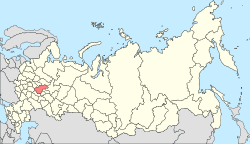Balakhna
| Balakhna (English) Балахна (Russian) |
|
|---|---|
| - Town - | |
 Location of Nizhny Novgorod Oblast in Russia |
|
|
|
|
|
|
|
|
|
|
| Administrative status (as of February 2014) | |
| Country | Russia |
| Federal subject | Nizhny Novgorod Oblast |
| Administrative district | Balakhninsky District |
| Town of district significance | Balakhna |
| Administrative center of | Balakhninsky District, town of district significance of Balakhna |
| Municipal status (as of February 2013) | |
| Municipal district | Balakhninsky Municipal District |
| Urban settlement | Balakhna Urban Settlement |
| Administrative center of | Balakhninsky Municipal District, Balakhna Urban Settlement |
| Statistics | |
| Population (2010 Census) | 51,519 inhabitants |
| - Rank in 2010 | 315th |
| Time zone | MSK (UTC+03:00) |
| Founded | 1474 |
| Previous names | Sol-na-Gorodtse |
| Postal code(s) | 606400, 606402, 606403, 606407, 606408, 606429 |
|
|
|
| on | |
Balakhna (Russian: Балахна́) is a town and the administrative center of Balakhninsky District in Nizhny Novgorod Oblast, Russia, located on the right bank of the Volga River, 32 kilometers (20 mi) north of Nizhny Novgorod, the administrative center of the oblast. Population: 51,519 (2010 Census);57,338 (2002 Census);32,133 (1989 Census); 33,500 (1968).
It was founded in 1474 as Sol-na-Gorodtse (Соль-на-Городце). After the Khan of Kazan razed it to the ground in 1536, a wooden fort was constructed to protect the settlement against further Tatar incursions. For the following three centuries, Balakhna prospered as a center of saltworks and grain trade. By the Time of Troubles, it was the twelfth largest city in Russia.
Adam Olearius visited and described the town in 1636. That year several shipwrights from Holstein built the first Russian ships here, thus establishing Balakhna as a foremost center of national river shipbuilding. The people of Balakhna were also reputed for their skills in knitting and making colored tiles, which were used for decoration of the Savior Church (1668) and other local temples. Balakhna is one of the few Russian cities shown on the 1689 Amsterdam World Map (labeled Balaghna).
The northwestern part of Balakhna is known as Pravdinsk. It used to be a separate urban-type settlement before it was merged into Balakhna in 1993. The settlement was named after the Moscow Pravda newspaper, which at some point may have been the largest consumer of newsprint produced at the local paper mill.
...
Wikipedia


